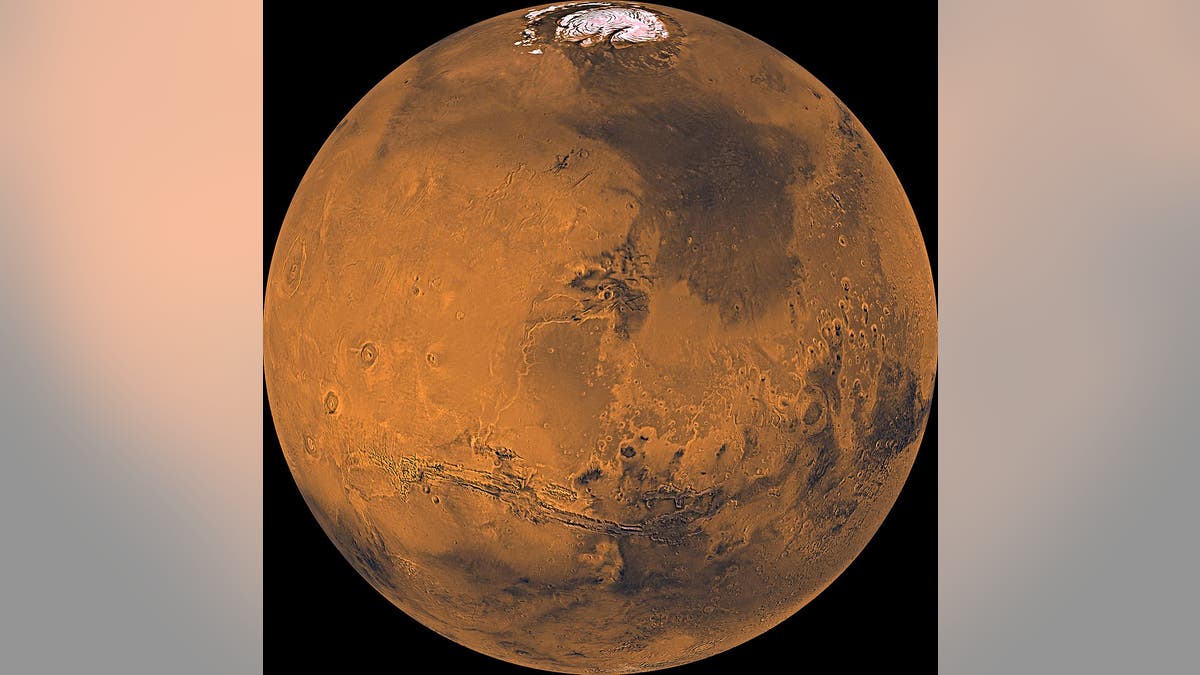Fox News Flash top headlines for Oct. 2
Fox News Flash top headlines for Oct. 1 are here. Check out what's clicking on Foxnews.com
In a startling interview, NASA's Planetary Science Division director Jim Green, Ph.D., has said the space agency is close to "making some announcements" about finding life on Mars — but that we're not ready for it.
“It will be revolutionary,” Green said in an interview with The Telegraph. “It’s like when Copernicus stated ‘no we go around the Sun.' Completely revolutionary. It will start a whole new line of thinking. I don’t think we’re prepared for the results. We’re not."
He added that he's worried because he believes NASA is close to finding life and making an announcement about it but wonders what will happen afterward.

Mars as seen from orbit in the 1970s by NASA’s Viking mission. (Credit: NASA)
ANCIENT MARS WAS WARM AND RAINY ENOUGH TO SUPPORT LIFE, STUDY SAYS
“What happens next is a whole new set of scientific questions," Green continued. "Is that life like us? How are we related? Can life move from planet to planet or do we have a spark and just the right environment and that spark generates life -- like us or not like us -- based on the chemical environment that it is in?”
In a statement to Fox News, NASA spokesman Allard Beutel said that the agency is excited about the mission to Mars, as well as future missions where the prospects of life have been raised.
"A key component of NASA’s work is to search for the building blocks and signs of life elsewhere, and we’re excited about the scientific findings of our rovers on Mars currently and upcoming, as well as missions to Europa, Titan, and other places," Beutel said via email. "Just as NASA astronauts landing on the Moon changed our conception of our place in the universe, the discovery of life elsewhere also would be a civilization changing event. As with all discoveries, NASA would work to confirm and share validated information with the world as soon as possible."
Next July, NASA is scheduled to launch its Mars 2020 rover in what it hopes will be a successful hunt for extraterrestrial life on the Red Planet. This past November, the space agency selected Jezero Crater as the landing spot for the rover, where it is expected to touch down on the surface of the planet on Feb. 18, 2021.
The 28-mile-wide Jezero Crater is on the western edge of Isidis Planitia, a giant impact basin north of the planet's equator. NASA noted that it is home to some of the "most scientifically interesting landscapes Mars has to offer," adding that it was once home to an ancient river delta, where ancient organic molecules and other signs of microbial life may be stored from billions of years ago.
Jezero Crater was chosen out of more than 60 locations.
In addition to the Mars 2020 mission, which is scheduled to launch at an estimated cost of more than $2 billion, according to Space News, the European Space Agency will also put a rover on Mars. The ExoMars rover is scheduled to land on the Red Planet on March 2021.
VENUS WAS LIKELY HABITABLE FOR 3B YEARS. THEN SOMETHING MYSTERIOUS HAPPENED.
Green said that these two missions provide an "opportunity to find life," adding that "we've never drilled that deep down" into the planet.
“When we first started the field of astrobiology in the 90s we started looking for extreme life," Green continued. "We go down in mines two miles deep into the Earth and if they were weeping with water they were full of life. We have gone in nuclear cesspools, places where you’d think nothing could survive, and they are full of life. And the bottom line is where there is water there is life."
In June 2018, NASA made a stunning announcement, noting the Curiosity rover "found organic molecules in rocks from an ancient lake bed.” The rocks are billions of years old, NASA said, before adding it had not found life on the planet.
A study presented in August suggested that the Red Planet was warm and wet enough to have massive rainstorms and flowing water, an environment that may have supported life, between 3 and 4 billion years ago.









































